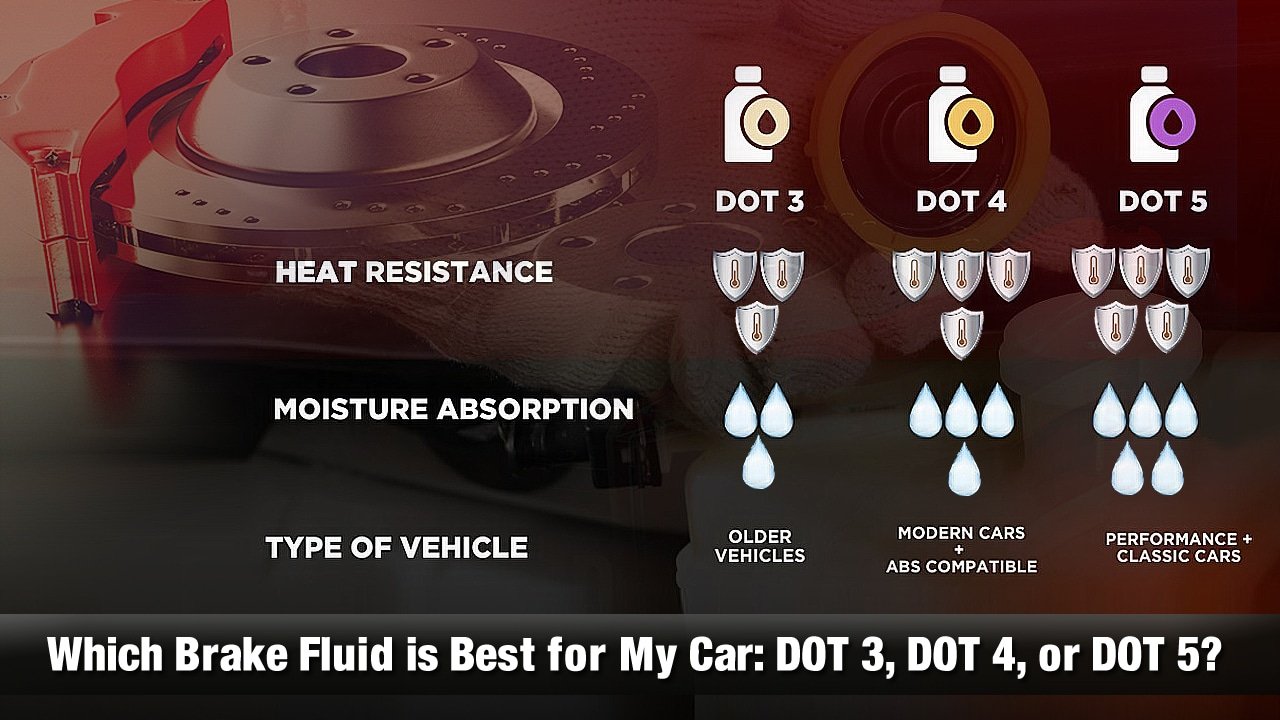
When it comes to staying safe on the road, every detail matters—and one of the most critical parts is brake fluid. This fluid sends the force from your foot on the brake pedal to the wheels, helping your car stop and stay under control.
But not all brake fluids are the same. In this guide, we will explain the different types of brake fluids (DOT 3, DOT 4, DOT 5, and DOT 5.1), what distinguishes them, and the pros and cons of each type. At Fubex Lubricants, we offer top-quality brake fluids for all vehicles. Enjoy fast shipping, a price match guarantee, and no-questions-asked returns.
Need help choosing the right oil? Call us at +971 50 544 9614 — our friendly team is ready to assist!
What Does Brake Fluid Do?
Brake fluid is vital for your car’s brakes. It is a special liquid that helps move the force from your foot on the brake pedal to the brakes on your vehicle.
When you press the brake pedal, a significant amount of heat is generated. This heat can make water form inside the brake system. Brake fluid absorbs this water, preventing it from boiling and causing the brakes to stop working.
It also helps keep the brake parts moving smoothly and stops them from rusting. Brake fluid must function effectively in both frigid and extremely hot temperatures. It should also mix safely with other brake fluids and protect the whole brake system from damage.
Understanding the Different Types of Brake Fluid
Brake fluid is labeled with the “DOT” designation and a corresponding number. DOT stands for the Department of Transportation, the agency responsible for establishing safety standards for brake fluids in the USA. These rules ensure the fluid works effectively and keeps everyone safe.
The higher the DOT number, the higher the boiling point. Most cars use DOT 3 or DOT 4, and they are amber in color (like light beer). These are glycol-based fluids, which means they can absorb water from the air. Because of this, always keep the bottle tightly closed and do not open the brake fluid reservoir unless needed. Over time, moisture and heat cause brake fluid to deteriorate. It can turn acidic, cause rust, and create debris that may damage expensive brake systems, such as ABS.
DOT 3
DOT 3 is the most common. Fresh DOT 3 boils at 401°F, but old DOT 3 can drop to 284°F. Hard braking, going downhill, towing, or racing can make it wear out faster. DOT 3 is also highly corrosive and can remove paint, so clean it up immediately if it is spilled.
DOT 4
DOT 4 is more commonly used in European cars but is gaining popularity worldwide. It has a higher boiling point than DOT 3, starting at 446°F, and has special additives to fight acids caused by moisture. DOT 3 and DOT 4 can mix, but it is not recommended. DOT 4 also costs about twice as much as DOT 3. Some types include:
- DOT 4 Plus – for Mercedes and Volvo
- DOT 4 Low Viscosity – for some BMW models
- DOT 4 Racing – often has a blue color
DOT 5
DOT 5 is silicone-based and has a very high boiling point of 500°F. It is usually purple to tell it apart from DOT 3 and 4. It does not absorb water like glycol fluids, but it can get foamy and trap air bubbles, which makes it bad for ABS systems. DOT 5 cannot be mixed with other fluids and costs approximately four times more than DOT 3.
DOT 5.1
DOT 5.1 is glycol-based like DOT 3 and 4, but has a boiling point similar to DOT 4 Racing. It is usually clear and can be mixed with DOT 3 or 4, but it is not recommended. DOT 5.1 is also much more expensive—about 14x more than DOT 3.
What Happens if Your Brake Fluid is Low?
Brake fluid works every day to help your car stop safely. But most people don’t think about it until there’s a problem. Over time, brake fluid can become contaminated, run low, or deteriorate. When this happens, your brakes may not function properly.
Here are some common signs of low or bad brake fluid:
ABS Light Turns On
Many newer cars have an ABS (Anti-Lock Braking System) light on the dashboard. If it lights up, it may indicate that the brake fluid level is low. Older cars may not have this light.
Brake Pads Don’t Work Properly
Low or dirty brake fluid can make it harder for the brake pads to press down. This can cause uneven wear and produce strange sounds, such as squealing or grinding, when you brake.
Strange Noises When Braking
If your brakes make noises, it might mean there isn’t enough brake fluid or the fluid is too old. Get your brakes checked right away.
Brake Pedal Feels Different
When brake fluid is low or needs to be changed, the brake pedal may not feel normal.
- If it feels too firm, the fluid may be dirty.
- If it feels soft, bouncy, or spongy, the fluid may be low.
Smoke or Burning Smell
If your brakes become too hot, you may notice smoke or smell something burning. Pull over and let them cool down. Driving like this can lead to brake failure and make it hard to stop your car.
The Benefits of Changing Brake Fluid
Changing your brake fluid regularly helps keep your car safe and prolong its lifespan. Here are some key benefits:
Better Braking
Fresh brake fluid helps your brakes work their best. This means you can stop your car quickly and safely when necessary.
Less Brake Fade
When you replace brake fluid on time, it reduces the chance of brake fade. This keeps your brakes strong, even in harsh conditions like steep hills or heavy traffic.
Longer Brake System Life
Good brake fluid helps protect parts from rust and wear. This means your brake system lasts longer.
Save Money
Regular brake fluid changes can prevent major problems before they occur. This helps you avoid expensive repairs.
Safer Driving
A well-maintained brake system makes driving safer for you and your passengers.
How Does Brake Fluid Affect Braking Performance?
Brake fluid plays a crucial role in determining the effectiveness of your brakes. Over time, small amounts of water can seep into the brake system through tiny pores in the brake lines or from air in the reservoir.
Brake fluid is designed to absorb moisture, which is helpful because it prevents rust and damage to brake parts. However, excessive water in the brake fluid can cause problems. It lowers the boiling point of the fluid. When the fluid gets too hot and starts to boil, the water turns into vapor. This causes the brake pedal to feel soft or spongy, preventing the brakes from working correctly.
That’s why it’s essential to flush and change the brake fluid regularly to keep your braking system strong and safe.
What Are the Main Characteristics of Brake Fluid?
The braking system becomes very hot when in use, so brake fluid requires special qualities to function effectively. The main characteristics include:
- Non-compressibility: It should not compress, allowing the force from the brake pedal to be transferred effectively to the brakes.
- Low VIscosity: Thin fluid helps brakes work better, especially in cars with ABS.
- Lubricity: Additives help the fluid lubricate seals and moving parts.
- Corrosion Resistance: Protects the brake system from rust and damage.
- High boiling Point: This allows the fluid to withstand very high heat without boiling, which could reduce braking power.
What’s the Difference Between DOT 3, DOT 4, and DOT 5 Brake Fluid?
When purchasing brake fluid, you will often see the labels marked with DOT 3, DOT 4, or DOT 5. DOT stands for Department of Transportation, which sets the standards for brake fluids. The numbers tell you the boiling points—both dry (fresh fluid) and wet (after it has absorbed moisture). A higher number usually indicates that the fluid can withstand more heat and last longer.
DOT 3
Most cars use DOT 3 brake fluid.
- Dry boiling point: 205°C
- Wet boiling point: 140°C
- This type is suitable for regular driving but requires more frequent changes because it absorbs moisture over time.
DOT 4
DOT 4 has:
- Dry boiling point: 230°C
- Wet boiling point: 155°C
- It can handle more heat and moisture than DOT 3, making it better for heavier braking or higher temperatures.
DOT 5
DOT 5 is different because it is silicone-based, unlike DOT 3 and DOT 4, which are glycol-based.
- Dry boiling point: 260°C
- Wet boiling point: 180°C
- It does not absorb moisture readily and lasts longer; however, it is typically not used in ABS systems.
DOT 5.1
DOT 5.1 has a boiling point similar to DOT 5 but is compatible with DOT 3 and DOT 4 systems. It offers high performance but is more expensive.
Can I Mix DOT 3, DOT 4, and DOT 5 Brake Fluids?
You can mix DOT 3 and DOT 4 brake fluids, but it’s not the best idea. Mixing them can cause contamination and lower braking performance. If you want to switch from DOT 3 to DOT 4, it’s better to drain and flush the old fluid first. Replacing the rubber parts in the braking system is also recommended when upgrading the vehicle.
DOT 5 is different. It is silicone-based and should never be mixed with DOT 3 or DOT 4, which are glycol-based brake fluids. Mixing them can cause poor braking or even make the wheels lock up.
DOT 5.1, however, is safe to mix with DOT 3 and DOT 4 because it is also glycol-based. It works well without harming braking performance.
Which Brake Fluid is Best for My Car?
The best way to know is to check your car’s owner’s manual. If it specifies DOT 4, then use DOT 4.
If you plan to upgrade, constantly drain the old brake fluid completely before adding new fluid.
Never mix DOT 3 or DOT 4 with DOT 5 because DOT 5 is silicone-based and not compatible. However, DOT 5.1 can be combined safely with DOT 3 and DOT 4, as it is also glycol-based.
Final Takeaways
Each type of brake fluid—DOT 3, DOT 4, DOT 5, and DOT 5.1—has its own pros and cons. The best brake fluid for your car depends on your vehicle’s needs and the type recommended by the manufacturer.
Keeping your braking system in good working order is crucial for your safety. Always follow your car’s manual and perform regular maintenance to ensure everything works properly.
With the correct brake fluid, you can drive with confidence, knowing your brakes will work when you need them most.
FAQs
Q1: Is DOT 5 better than DOT 4?
DOT 5 offers better performance, especially for sport bikes, but it is not always compatible with DOT 4 systems. Always use the brake fluid recommended for your vehicle to avoid damage.
Q2: Does it matter which brake fluid I use, like DOT 3 or DOT 5?
Yes, it matters. DOT 5 is not compatible with systems made for DOT 3 or DOT 4, and mixing them can cause brake problems. Always check your owner’s manual and use the brake fluid recommended by your car.

Editor-at-Large
A passionate writer in the lubricant industry, Awais Iqbal has been covering oils, greases, and industrial fluids since the start of his career. At 25, he’s already written for blogs, catalogs, and brand guides across the UAE. Awais’s insights help companies connect with their audience, and his clear, helpful writing style is trusted by brands in the region.


